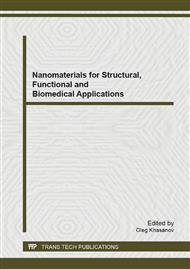p.36
p.45
p.52
p.60
p.65
p.70
p.74
p.79
p.84
Peculiarities of Surface Fracture of B4C Ceramics under Loads
Abstract:
The paper presents experimental results showing the nature of the destruction in the surface layer of В4С ceramics during hardness and fracture toughness tests performed by Vickers diamond pyramid indentation with different applied loads (4.91 - 294.3 N). Ceramics made from boron carbide powder with 10 wt.% additive of submicron fraction of the same powder sintered in spark discharge plasma by Spark Plasma Sintering (SPS-method) under different sintering conditions was studied. Changes of micro hardness and hardness of the samples were measured by micro hardness tester PМТ-3М with the loads Р up to 4.9 N; by micro hardness tester Micromet with P= 9.811.77 N; and by hardness tester ТP-7R-1 with the loads of 49 - 294.3 N. Indentation, exposure, and unloading were carried out according to standard method during 30-40 seconds. The microstructure and topography of the surface of ceramic samples splits after indentation were studied by scanning electron microscopy (SEM, microscope JEOL SEM-7500FA). The profiles of the split surface depth were determined by Linnik interferometer МII-4.
Info:
Periodical:
Pages:
65-69
Citation:
Online since:
December 2013
Price:
Сopyright:
© 2014 Trans Tech Publications Ltd. All Rights Reserved
Share:
Citation:


